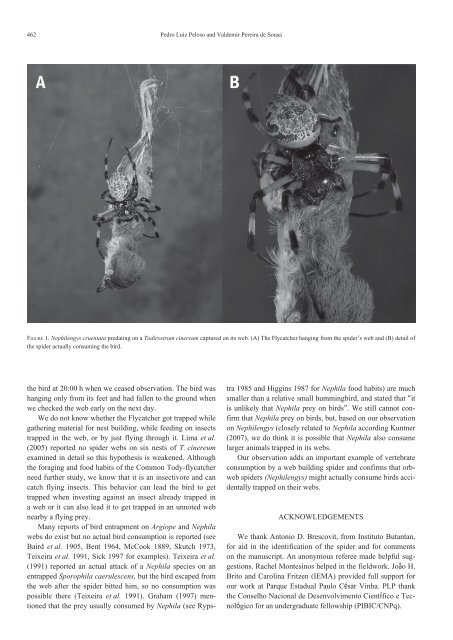You also want an ePaper? Increase the reach of your titles
YUMPU automatically turns print PDFs into web optimized ePapers that Google loves.
462 Pedro Luiz Peloso and Valdemir Pereira de Sousa<br />
FiguRe 1. Nephilengys cruentata pre<strong>da</strong>ting on a Todirostrum cinereum captured on its web. (A) The Flycatcher hanging from the spider’s web and (B) detail of<br />
the spider actually consuming the bird.<br />
the bird at 20:00 h when we ceased observation. The bird was<br />
hanging only from its feet and had fallen to the ground when<br />
we checked the web early on the next <strong>da</strong>y.<br />
We do not know whether the Flycatcher got trapped while<br />
gathering material for nest building, while feeding on insects<br />
trapped in the web, or by just flying through it. Lima et al.<br />
(2005) reported no spider webs on six nests of T. cinereum<br />
examined in detail so this hypothesis is weakened. Although<br />
the foraging and food habits of the Common Tody‑flycatcher<br />
need further study, we know that it is an insectivore and can<br />
catch flying insects. This behavior can lead the bird to get<br />
trapped when investing against an insect already trapped in<br />
a web or it can also lead it to get trapped in an unnoted web<br />
nearby a flying prey.<br />
Many reports of bird entrapment on Argiope and Nephila<br />
webs do exist but no actual bird consumption is reported (see<br />
Baird et al. 1905, Bent 1964, McCook 1889, Skutch 1973,<br />
Teixeira et al. 1991, Sick 1997 for examples). Teixeira et al.<br />
(1991) reported an actual attack of a Nephila species on an<br />
entrapped Sporophila caerulescens, but the bird escaped from<br />
the web after the spider bitted him, so no consumption was<br />
possible there (Teixeira et al. 1991). Graham (1997) men‑<br />
tioned that the prey usually consumed by Nephila (see Ryps‑<br />
tra 1985 and Higgins 1987 for Nephila food habits) are much<br />
smaller than a relative small hummingbird, and stated that “it<br />
is unlikely that Nephila prey on birds”. We still cannot con‑<br />
firm that Nephila prey on birds, but, based on our observation<br />
on Nephilengys (closely related to Nephila according Kuntner<br />
(2007), we do think it is possible that Nephila also consume<br />
larger animals trapped in its webs.<br />
Our observation adds an important example of vertebrate<br />
consumption by a web building spider and confirms that orb‑<br />
web spiders (Nephilengys) might actually consume birds acci‑<br />
dentally trapped on their webs.<br />
ACKNOWLEDGEMENTS<br />
We thank Antonio D. Brescovit, from Instituto Butantan,<br />
for aid in the identification of the spider and for comments<br />
on the manuscript. An anonymous referee made helpful sug‑<br />
gestions. Rachel Montesinos helped in the fieldwork. João H.<br />
Brito and Carolina Fritzen (IEMA) provided full support for<br />
our work at Parque Estadual Paulo César Vinha. PLP thank<br />
the Conselho Nacional de Desenvolvimento Científico e Tec‑<br />
nológico for an undergraduate fellowship (PIBIC/CNPq).

















